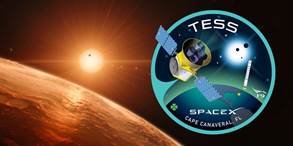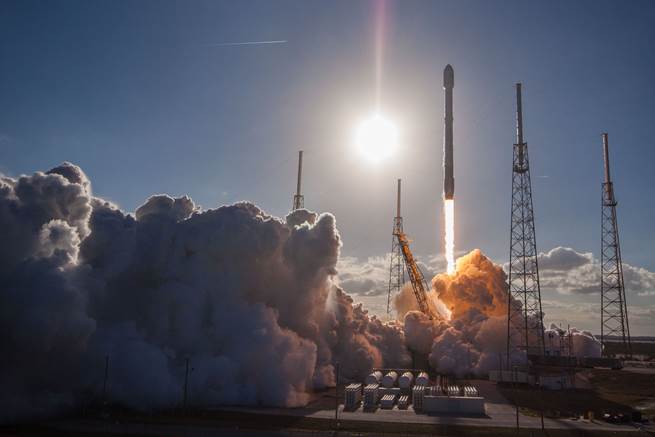|
Transiting Exoplanet Survey Satellite
(TESS)
UW Astrobiology Faculty
Member Dr. Eric Agol is a Professor of Astronomy and a TESS Science Team
Member.† Here he uses his expertise and
insights to describes the TESS advantage in the search for other worlds that
could harbor life!
By Dr.
Eric Agol
Professor Astronomy & Astrobiology
 Anticipation has been
building for the discovery of new exoplanets with the recent successful
launch of the TESS spacecraft on April 18th. TESS
uses the same approach as Kepler in searching for periodic transits of stars
by planets whose orbits pass in front of the star. However, Kepler
surveyed only 100 square degrees, while TESS will survey the whole sky
(nearly), an area about 400 times greater than the area covered by
Kepler. In order to carry this out, TESS is designed with four
wide-field cameras which each view about five times the area of Kepler, for a
total of about twenty times the viewing area. However, the
trade-off with the field of view is that TESS has a much smaller photon
collecting area: each TESS camera looks through optics which are similar to a
telephoto lens. TESS will also survey each portion of the sky for
only four weeks at a time (although with longer duration of coverage near the
poles), with 13 survey fields of the Northern sky for a year, followed by the
Southern sky. So for a given star, TESS is less sensitive than
Kepler, and will find planets with larger transit depths in shorter orbital
periods, However, TESSí full-sky coverage will enable an extensive survey of
planets around the brightest stars, which are more likely to be closer to us,
in comparison to the Keplerís small area, deep survey, that found planets
around stars that were much farther away.† Anticipation has been
building for the discovery of new exoplanets with the recent successful
launch of the TESS spacecraft on April 18th. TESS
uses the same approach as Kepler in searching for periodic transits of stars
by planets whose orbits pass in front of the star. However, Kepler
surveyed only 100 square degrees, while TESS will survey the whole sky
(nearly), an area about 400 times greater than the area covered by
Kepler. In order to carry this out, TESS is designed with four
wide-field cameras which each view about five times the area of Kepler, for a
total of about twenty times the viewing area. However, the
trade-off with the field of view is that TESS has a much smaller photon
collecting area: each TESS camera looks through optics which are similar to a
telephoto lens. TESS will also survey each portion of the sky for
only four weeks at a time (although with longer duration of coverage near the
poles), with 13 survey fields of the Northern sky for a year, followed by the
Southern sky. So for a given star, TESS is less sensitive than
Kepler, and will find planets with larger transit depths in shorter orbital
periods, However, TESSí full-sky coverage will enable an extensive survey of
planets around the brightest stars, which are more likely to be closer to us,
in comparison to the Keplerís small area, deep survey, that found planets
around stars that were much farther away.†
 These brighter host stars
that TESS will find planets around are more amenable to follow-up with
ground-based Doppler/radial-velocity measurements, and will also be
advantageous when searching for atmospheric spectral transmission features
with the James Webb Space Telescope. In addition, TESS will
include a larger fraction of M dwarf stars, whose smaller dimensions giving
the satellite some chance of finding rocky, temperate planets in the
Habitable Zone of their parent stars. These brighter host stars
that TESS will find planets around are more amenable to follow-up with
ground-based Doppler/radial-velocity measurements, and will also be
advantageous when searching for atmospheric spectral transmission features
with the James Webb Space Telescope. In addition, TESS will
include a larger fraction of M dwarf stars, whose smaller dimensions giving
the satellite some chance of finding rocky, temperate planets in the
Habitable Zone of their parent stars.
An additional difference
between TESS and Kepler is that TESS is a satellite (orbiting Earth), while
Kepler is a spacecraft (orbiting the Sun). This means that to
avoid the Earth, TESS has been given an elongated orbit which is resonant
with the Moon (to avoid a collision). TESS spends most of its
orbit (near apogee) away from the Earth where it can survey the sky
unobstructed for four weeks before needing to re-orient itself to avoid the
Sun. During the short perigee passage (closest approach), TESS
gets close enough to Earth to transmit data it has collected with higher
bandwidth. This proximity to Earth enables a higher data
collection rate than Kepler, meaning that TESS can download its entire field
of view with a cadence of 30 minutes (and a smaller portion with targeted
stars using a 2-minute cadence), enabling a broader search for variable
phenomena than was allowed by the Kepler spacecraft. As with most
of astronomy, when new capabilities are opened, usually the most interesting
discoveries are unanticipated. It falls on us to search the TESS
data for whatever secrets the Universe is willing to divulge."

Liftoff of the SpaceX Falcon
9 rocket from Cape Canaveral Air Force Station carrying TESS into a high
earth orbit
|




